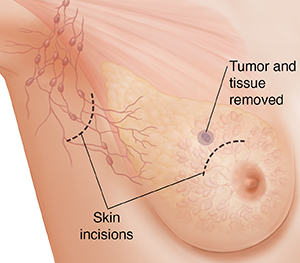Types of Surgery for Breast Cancer
Types of Surgery for Breast Cancer
Several types of surgery are used to treat breast cancer. The goal of each is to remove all the cancer cells. You and your surgeon will decide which approach is best for you. Breast reconstruction is often an option after breast surgery to remove cancer. Reconstruction is plastic surgery to rebuild the breast shape.
| |
| |
| |
Lumpectomy
The goal of lumpectomy is to remove the cancer while keeping as much of the breast as possible. In fact, lumpectomy may also be called breast-conserving surgery. To do this surgery, the surgeon removes the breast tissue that contains the cancer cells. A margin or edge of normal tissue around the cancer is also taken out. This surgery may not need a hospital stay. In most cases, it is followed by radiation therapy.
Simple mastectomy
During a simple or total mastectomy, the surgeon removes all of the breast tissue, plus the nipple. Underarm lymph nodes and the chest muscles are not removed. This surgery most often needs a hospital stay. Based on the results of surgery and follow-up tests, more treatment may also be needed.
Modified radical mastectomy
During modified radical mastectomy, the surgeon removes all the breast tissue and the nipple. Many of the lymph nodes in the armpit near the breast are removed as well. The lining over the chest muscles and sometimes the muscles themselves are also removed. This surgery most often needs a hospital stay. Based on the results of follow-up tests, more treatment may be needed.
If cancer cells break away from a tumor, they can travel in the lymph fluid to nearby lymph nodes. During surgery, your first lymph node or nodes may be removed and checked for cancer. This is called a sentinel node biopsy. In some cases, all of the nodes are removed. If the nodes contain cancer, more treatment is often needed because the cancer may have spread to other parts of the body.
Risks of breast and lymph node surgery include:
-
Pain (which improves as you heal and recover)
-
Numbness (due to nerve damage)
-
Bleeding or infection
-
Fluid collection inside the breast (seroma)
-
Long-term swelling of the arm, hand, or chest (lymphedema)
-
Shoulder stiffness
Your healthcare team can tell you what to expect based on the type of surgery you have.
Updated:
March 15, 2019
Reviewed By:
Gersten, Todd, MD,Image reviewed by StayWell medical illustration team.
